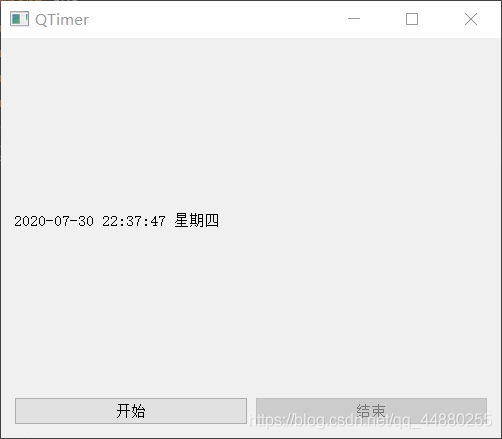| 方法 | 描述 |
|---|---|
| start(milliseconds) | 启动或重新启动定时器,时间间隔为毫秒。如果定时器已经运行,它将被停止并重新启动。如果singleShot信号为真,定时器将仅被激活一次 |
| Stop() | 停止定时器 |
| 信号 | 描述 |
|---|---|
| singleShot | 在给定的时间间隔后调用一个槽函数时发射此信号 |
| timeout | 当定时器超时时发射此信号 |
示例1:
import sys
from PyQt5 import QtCore
from PyQt5.QtWidgets import *
from PyQt5.QtGui import *
from PyQt5.QtCore import *
class Demo(QWidget):
count = 0
def __init__(self):
super().__init__()
self.setGeometry(100, 50, 500, 400)
self.setWindowTitle('QTimer')
self.list = QListWidget()
self.label = QLabel('显示当前时间')
self.start = QPushButton('开始')
self.end = QPushButton('结束')
layout = QGridLayout()
#初始化定时器
self.timer = QTimer(self)
self.timer.timeout.connect(self.showTime)
self.start.clicked.connect(self.startTimer)
self.end.clicked.connect(self.endTimer)
layout.addWidget(self.label,0,0,1,2)
layout.addWidget(self.start,1,0)
layout.addWidget(self.end,1,1)
self.setLayout(layout)
def showTime(self):
#获取系统现在的时间
time = QDateTime.currentDateTime().toString('yyyy-MM-dd hh:mm:ss dddd')
self.label.setText(time)
def startTimer(self):
#设置时间间隔并启动定时器
self.timer.start(1000)
self.start.setEnabled(False)
self.end.setEnabled(True)
def endTimer(self):
#关闭定时器
self.timer.stop()
self.start.setEnabled(True)
self.end.setEnabled(False)
if __name__ == "__main__":
app = QApplication(sys.argv)
form = Demo()
form.show()
sys.exit(app.exec_())
运行效果如下:

示例2:
import sys
from PyQt5 import QtCore
from PyQt5.QtWidgets import *
from PyQt5.QtGui import *
from PyQt5.QtCore import *
if __name__ == "__main__":
app = QApplication(sys.argv)
label = QLabel('font color=blue size=20>b>PyQt5,窗口5秒后消失/b>/font>')
#无边框窗口
label.setWindowFlags(Qt.SplashScreen|Qt.FramelessWindowHint)
label.show()
#设置5秒后自动退出
QTimer.singleShot(5000,app.quit)
sys.exit(app.exec_())
运行效果如下:

我正在使用python创建程序,并且正在使用pyqt。我目前正在使用QTimer,我想每秒钟打印一次“ timer works”,并在5秒钟后停止打印。这是我的代码:
timers = []
def thread_func():
print("Thread works")
timer = QtCore.QTimer()
timer.timeout.connect(timer_func)
timer.start(1000)
print(timer.remainingTime())
print(timer.isActive())
timers.append(timer)
def timer_func():
print("Timer works")
解决方案
以下是一个简单的演示,显示了如何创建在固定数量的超时后停止计时的计时器。
from PyQt5 import QtCore
def start_timer(slot, count=1, interval=1000):
counter = 0
def handler():
nonlocal counter
counter += 1
slot(counter)
if counter >= count:
timer.stop()
timer.deleteLater()
timer = QtCore.QTimer()
timer.timeout.connect(handler)
timer.start(interval)
def timer_func(count):
print('Timer:', count)
if count >= 5:
QtCore.QCoreApplication.quit()
app = QtCore.QCoreApplication([])
start_timer(timer_func, 5)
app.exec_()
到此这篇关于PyQt5中QTimer定时器的实例代码的文章就介绍到这了,更多相关PyQt5 QTimer定时器内容请搜索脚本之家以前的文章或继续浏览下面的相关文章希望大家以后多多支持脚本之家!